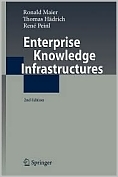Success of an organization is increasingly dependent on its capability to
create an environment in order to improve productivity of knowledge work.
This book focuses on the concepts, models and technologies that are used to
design and implement such an environment. It develops the vision of a modular, yet highly
integrated enterprise knowledge infrastructure and presents an idealized architecture
replete with current technologies and systems. The most important streams of technological
development that are covered in the book are communication, collaboration, document and
content management, e-learning, enterprise portals, business process management,
information life cycle management, information retrieval and visualization, knowledge
management, mobile computing, application and network infrastructure, Semantic Web and
social software. It includes learning goals, exercises and case examples that help the
reader to easily understand and practice the concepts.
Table of Contents
1 Foundation
1.1 Knowledge
1.1.1 Knowledge in Organizational Settings
1.1.2 Definition
1.2 Knowledge Work
1.2.1 Definition and Characteristics
1.2.2 Traditional Work versus Knowledge Work
1.3 Knowledge Management
1.3.1 Roots of Knowledge Management
1.3.2 From Data to Knowledge Management
1.3.3 Definition
1.4 Knowledge Management Instruments
1.4.1 Definition
1.4.2 Product-oriented Instruments
1.4.3 Process-oriented Instruments
1.4.4 Knowledge Maturing
1.5 Information System Architectures
1.5.1 System Architectures
1.5.2 Enterprise Architectures
1.6 Knowledge Infrastructures
1.6.1 Definition
1.6.2 Knowledge Management Services
1.6.3 Architecture of Knowledge Infrastructures
2 Infrastructure
2.1 Network Infrastructure
2.1.1 Topologies
2.1.2 Geographical Expansion
2.1.3 Layered Network Architecture
2.2 Network Standards
2.2.1 Physical and Data Link Layer
2.2.2 Network and Transport Layer
2.2.3 Application Layer
2.2.4 Network Management
2.2.5 Network Hardware
2.3 Infrastructure Services
2.3.1 Storage
2.3.2 Security
2.3.3 Application Infrastructure
3 Integration Services
3.1 Data Integration
3.1.1 Semi-structured Data
3.1.2 Uniform Resource Identifier and Unicode
3.1.3 Extensible Markup Language (XML)
3.1.4 XML Schema
3.1.5 XSL Transformation
3.2 Meta-data-based Integration .
3.2.1 Meta-data Standards
3.2.2 Resource Description Framework (RDF)
3.2.3 Storing and Querying Meta-data
3.2.4 Meta-data Dimensions
3.3 Ontology-based Integration
3.3.1 Ontology
3.3.2 RDF Schema
3.3.3 Web Ontology Language (OWL)
3.3.4 Higher Levels of the Semantic Web Stack
3.4 Function and Process Integration
3.4.1 Function Integration
3.4.2 Process Integration
3.4.3 Web Service Composition
3.4.4 Semantic Web Services
4 Knowledge Services
4.1 Investigation Services
4.1.1 Foundation
4.1.2 Exploration
4.1.3 Search .
4.1.4 Presentation
4.1.5 Monitoring
4.2 Individuation Services
4.2.1 Foundation
4.2.2 Experience
4.2.3 Expression
4.2.4 Competence
4.2.5 Expertise
4.3 Interaction Services
4.3.1 Foundation
4.3.2 Initiation
4.3.3 Networking
4.3.4 Communication
4.3.5 Community
4.4 In-form-ation Services
4.4.1 Foundation
4.4.2 Capturing
4.4.3 Manipulation
4.4.4 Translation
4.4.5 Archiving
4.5 Instruction Services
4.5.1 Foundation
4.5.2 Enriching
4.5.3 Composition
4.5.4 Consumption
4.5.5 Assessment
5 Access Services
5.1 Server-side Access Technologies
5.1.1 Portals
5.1.2 Personalization
5.2 Client-side Access Technologies
5.2.1 Thin Clients
5.2.2 Rich Thin Clients
5.2.3 Rich Clients
5.2.4 Desktop Integration .
5.3 Mobile Access
5.3.1 Mobile Computing
5.3.2 Mobile Devices
5.3.3 Mobile Applications .
6 Conclusion
6.1 Situation-oriented Support of Knowledge Work
6.2 Context Factors for Knowledge Sharing
6.3 State-of-Practice of Knowledge Management
6.4 Centralized versus Distributed Architectures
6.5 Chances and Risks of Web 2.0 from a Knowledge Perspective
6.6 The Future of Knowledge Infrastructures
Bibliography
Index
445 pages, Paperback


